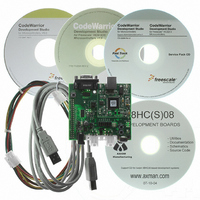DEMO9S08EL32 Freescale Semiconductor, DEMO9S08EL32 Datasheet - Page 54

DEMO9S08EL32
Manufacturer Part Number
DEMO9S08EL32
Description
BOARD DEMO FOR 9S08 EL MCU
Manufacturer
Freescale Semiconductor
Type
MCUr
Datasheets
1.DEMO9S08EL32.pdf
(356 pages)
2.DEMO9S08EL32.pdf
(14 pages)
3.DEMO9S08EL32.pdf
(2 pages)
Specifications of DEMO9S08EL32
Contents
Evaluation Board
Processor To Be Evaluated
MC9S08EL32
Data Bus Width
8 bit
Interface Type
RS-232, USB
Operating Supply Voltage
12 V
Silicon Manufacturer
Freescale
Core Architecture
HCS08
Core Sub-architecture
HCS08
Silicon Core Number
MC9S08
Silicon Family Name
S08EL
Rohs Compliant
Yes
For Use With/related Products
MC9S08EL32
Lead Free Status / RoHS Status
Lead free / RoHS Compliant
- Current page: 54 of 356
- Download datasheet (9Mb)
Chapter 4 Memory
FOPT register in high-page register space. A user engages security by programming the NVOPT location,
which can be performed at the same time the FLASH memory is programmed. The 1:0 state disengages
security; the other three combinations engage security. Notice the erased state (1:1) makes the MCU
secure. During development, whenever the FLASH is erased, it is good practice to immediately program
the SEC0 bit to 0 in NVOPT so SEC = 1:0. This would allow the MCU to remain unsecured after a
subsequent reset.
The on-chip debug module cannot be enabled while the MCU is secure. The separate background debug
controller can be used for background memory access commands of unsecured resources.
A user can choose to allow or disallow a security unlocking mechanism through an 8-byte backdoor
security key. If the nonvolatile KEYEN bit in NVOPT/FOPT is 0, the backdoor key is disabled and there
is no way to disengage security without completely erasing all FLASH locations. If KEYEN is 1, a secure
user program can temporarily disengage security by:
The security key can be written only from secure memory (either RAM, EEPROM, or FLASH), so it
cannot be entered through background commands without the cooperation of a secure user program.
The backdoor comparison key (NVBACKKEY through NVBACKKEY+7) is located in FLASH memory
locations in the nonvolatile register space so users can program these locations exactly as they would
program any other FLASH memory location. The nonvolatile registers are in the same 768-byte block of
FLASH as the reset and interrupt vectors, so block protecting that space also block protects the backdoor
comparison key. Block protects cannot be changed from user application programs, so if the vector space
is block protected, the backdoor security key mechanism cannot permanently change the block protect,
security settings, or the backdoor key.
Security can always be disengaged through the background debug interface by taking these steps:
54
1. Writing 1 to KEYACC in the FCNFG register. This makes the FLASH module interpret writes to
2. Writing the user-entered key values to the NVBACKKEY through NVBACKKEY+7 locations.
3. Writing 0 to KEYACC in the FCNFG register. If the 8-byte key that was written matches the key
1. Disable any block protections by writing FPROT. FPROT can be written only with background
2. Mass erase FLASH if necessary.
3. Blank check FLASH. Provided FLASH is completely erased, security is disengaged until the next
To avoid returning to secure mode after the next reset, program NVOPT so SEC = 1:0.
the backdoor comparison key locations (NVBACKKEY through NVBACKKEY+7) as values to
be compared against the key rather than as the first step in a FLASH program or erase command.
These writes must be performed in order starting with the value for NVBACKKEY and ending
with NVBACKKEY+7. STHX must not be used for these writes because these writes cannot be
performed on adjacent bus cycles. User software normally would get the key codes from outside
the MCU system through a communication interface such as a serial I/O.
stored in the FLASH locations, SEC bits are automatically changed to 1:0 and security will be
disengaged until the next reset.
debug commands, not from application software.
reset.
MC9S08EL32 Series and MC9S08SL16 Series Data Sheet, Rev. 3
Freescale Semiconductor
Related parts for DEMO9S08EL32
Image
Part Number
Description
Manufacturer
Datasheet
Request
R
Part Number:
Description:
Manufacturer:
Freescale Semiconductor, Inc
Datasheet:
Part Number:
Description:
Manufacturer:
Freescale Semiconductor, Inc
Datasheet:
Part Number:
Description:
Manufacturer:
Freescale Semiconductor, Inc
Datasheet:
Part Number:
Description:
Manufacturer:
Freescale Semiconductor, Inc
Datasheet:
Part Number:
Description:
Manufacturer:
Freescale Semiconductor, Inc
Datasheet:
Part Number:
Description:
Manufacturer:
Freescale Semiconductor, Inc
Datasheet:
Part Number:
Description:
Manufacturer:
Freescale Semiconductor, Inc
Datasheet:
Part Number:
Description:
Manufacturer:
Freescale Semiconductor, Inc
Datasheet:
Part Number:
Description:
Manufacturer:
Freescale Semiconductor, Inc
Datasheet:
Part Number:
Description:
Manufacturer:
Freescale Semiconductor, Inc
Datasheet:
Part Number:
Description:
Manufacturer:
Freescale Semiconductor, Inc
Datasheet:
Part Number:
Description:
Manufacturer:
Freescale Semiconductor, Inc
Datasheet:
Part Number:
Description:
Manufacturer:
Freescale Semiconductor, Inc
Datasheet:
Part Number:
Description:
Manufacturer:
Freescale Semiconductor, Inc
Datasheet:
Part Number:
Description:
Manufacturer:
Freescale Semiconductor, Inc
Datasheet:










